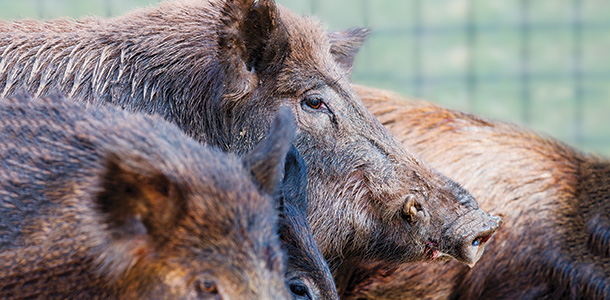Trapping wild pigs can be a daunting task. Certain uses and types of traps may have caused them to become more aware of structures built for confinement. This is where we get the term “trap-shy.” Often, when traps are set up, pigs abandon the bait or consume bait only up to the gate, never crossing the threshold into the trap.
Even the best trappers fail, but studying hog behavior and learning from our mistakes helps make us more successful.
Watch a related video featuring the BoarBuster hybrid feral swine trap.
The first thing to consider when trapping wild pigs is bait placement. A location where damage is observed is not always the best location to trap. Take the trap to the pig, don’t try to bring the pig to the trap.
In selecting a proper trapping location, follow the trail that leads to the damage. Find where the pigs are spending the daytime.
This is often in dense thickets near water. By placing the bait closer to their bedding area, the bait is the first thing they encounter when they head out to feed and will allow us to more accurately pattern the sounder (group of hogs).
Many different types of bait have been used to attract wild pigs. No single bait is best in every situation, but avoid switching bait in the middle of trapping.
When pre-baiting (baiting a site before erecting a trap), place the bait near the timber or water source and provide only enough bait so the pigs consume all of it in 30 minutes. This forces the pigs to “eat like pigs.”
Providing a large quantity of bait on a daily basis is expensive and allows pigs to take turns feeding. Avoid using tube feeders that limit the number of pigs feeding at one time.

When the quantity of bait is limited, all individuals in the sounder are forced to eat immediately or risk not getting anything to eat.
Later, when traps are set, there is a better chance of catching the entire sounder when the animals are conditioned to hurry to the bait.
Infrared-triggered trail cameras are a tremendous tool for effective pig trapping. They provide information to help select the appropriate trap style and size, and learn pigs’ active periods.
If only a few pigs are using the bait, the trap does not need to be very large.
Alternatively, if a large group is using the bait, the trap should be large enough to trap the entire sounder in one capture.
Looking at photos helps determine the size of trap needed. Pay attention to the orientation of the pigs as they consume the bait.
Look at the distance between the pigs as they eat and use a trap that allows the pigs to maintain comfortable spaces. Also pay attention to the time when the pigs are using the bait site.
A pattern will likely develop over a few days. Be mindful to never visit the site during those times.
Trapping pigs in corral or box traps is a process that occurs over several days, if not weeks. Do not expect to set up these traps, bait them and catch pigs overnight.
Pre-baiting should occur until the pigs establish a pattern over three or more consecutive days. Using this surveillance information, set up the trap during a period of inactivity and do not set the trigger.
The second part of the process is getting the pigs familiar with the trap. Leaving large openings in corral traps or trailing bait through the openings can accelerate habituation time.
Use the camera to determine when the entire group is comfortable entering and feeding in the trap before setting the trigger.
For more information on wild pigs and new trapping technologies, see “The Feral Hog in Oklahoma” and “BoarBuster Thinks Outside the Box Trap”. ![]()
—Excerpts from The Samuel Roberts Noble Foundation AgNews and Views e-newsletter, December 2013
PHOTOS
Catching feral hogs is a process that takes time, both in capturing and getting pigs familiar with the trap. Photos courtesy of Noble Foundation.










